Researchers use data from ESA’s Gaia telescope to discover that white dwarf stars have two different distributions both in how they move and how bright they shine. Plus, all the International Space Station news, simulated JWST observations, and a review of a macro lens from Venus Optics.
Podcast
Show Notes
NASA to cover return to Earth of Mark Vande Hei
- NASA press release
80th U.S. EVA on ISS completed despite issues
Northrop Grumman proposes Chandra servicing mission
- Irene Klotz thread (Twitter)
Two CubeSats deployed from the ISS
- PDF: KITSUNE Armature CW Information (Kyushu Institute of Technology)
- Yeet video
First “off-planet art gallery” launched to ISS
- PDF: Moon Gallery press release
Gaia brings us weird White Dwarf news
- Lund University press release
- “The velocity distribution of white dwarfs in Gaia EDR3,” Daniel Mikkola, Paul J. McMillan, David Hobbs, and John Wimarsson, to be published in Monthly Notices of the Royal Astronomical Society (preprint on arxiv.org)
New simulations hint at details JWST may reveal
- CfA Harvard | Smithsonian press release
- “The THESAN project: Lyman-α emission and transmission during the Epoch of Reionization,” A Smith et al., 2022 March 24, Monthly Notices of the Royal Astronomical Society
Lens Review: Laowa 15mm f/4 Macro
- Laowa 15mm f/4 Wide Angle Macro product page (Venus Optics)
Transcript
Today’s episode has an awful lot happening on the ISS, from a spacewalk to an art piece to not one but two CubeSats being yote into orbit
Plus, a NASA astronaut is preparing to return to Earth, and the Gaia mission tells us just how big some white dwarfs are. Finally, Erik has a macro lens to review.
All of this and more is coming at you, right here on the Daily Space.
I am your host Dr. Pamela Gay.
And I am your host Erik Madaus.
And we’re here to put science in your brain.

Last week, we addressed some concerns about just how and when one of the International Space Station (ISS) astronauts would return to Earth from the ISS. Under normal circumstances, a return trip on Soyuz wouldn’t even be a question, but with the war in Ukraine and Russia’s ongoing sanctions against opposing countries, we had to rely on NASA’s reassurance that everything would be fine and that there are backup plans in place.
With all of that in mind, on March 24, NASA announced the planned coverage for the return of Soyuz MS-19, where American astronaut Mark Vande Hei will be returning with two Russian astronauts, Pyotr Dubrov and Anton Shkaplerov. Dubrov and Vande Hei will be returning after 355 continuous days in space, which set a new record for American astronauts by fifteen days.
The first event will be the morning of March 29 when the current ISS commander, Anton Shkaplerov, will transfer command of the ISS to NASA astronaut Thomas Marshburn in a symbolic change of command ceremony at 13:45 UTC. Just under nine hours later at 02:30 UTC on the 30th, there will be three events: hatch closure at 12:00 UTC, undocking at 03:21 UTC, and the deorbit burn followed by the landing at 07:28 UTC in Kazakhstan.
We mentioned last week that there was an EVA coming up. It took place this week. There were some minor equipment problems, but the EVA was completed fully and safely.
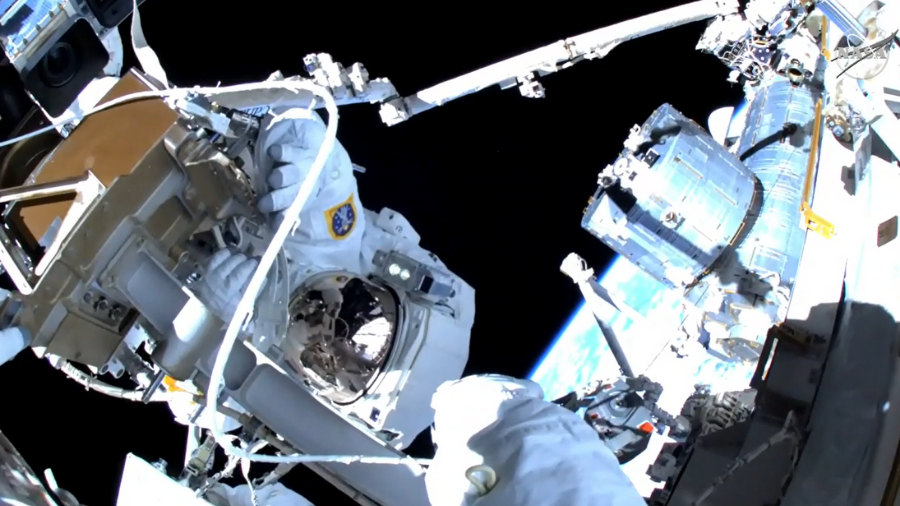
The purpose of this EVA was to add hoses to the module that circulates coolant around stations radiators. It started at 12:32 UTC on the 24th and lasted six hours 54 minutes, exactly the same as the previous EVA, which was purely a coincidence.
From the beginning, the German astronaut, Mattias Maurer, had problems with his spacesuit. Right after departing the airlock, there was a problem with a cable for one of his gloves’ heaters, so he was forced to go without heaters in the glove for the duration of the spacewalk.
Then one of the cameras on his helmet came loose and had to be secured with wire ties by the other astronaut, Raja Chari. The helmet cam is a critical piece of equipment as it allows ground control to see what the astronauts are seeing to help with any problems.
With those issues resolved, the astronauts went on to complete their primary task, installing the hoses from the “Radiator Beam Valve module” to a radiator. The astronauts worked on different tasks at the same time, with Maurer first running some ethernet cables to a platform on the outside of the station before helping Chari with the radiator. The platform will be used to host commercial payloads for European customers. The astronauts wrapped up the spacewalk by installing a new HD camera on the outside of the station.
After finishing the tasks, the two astronauts re-entered the airlock and repressurized it. Maurer was first because he noted that almost 50% of his faceplate was covered in water. A leak like this has happened before during a spacewalk in 2013. In response to that leak, NASA added a Helmet Absorbency Pad (HAP) to absorb future leaks. Unsurprisingly, the HAP on Maurer’s helmet was damp. But both spacewalkers were okay overall, and the EVA was considered a success.
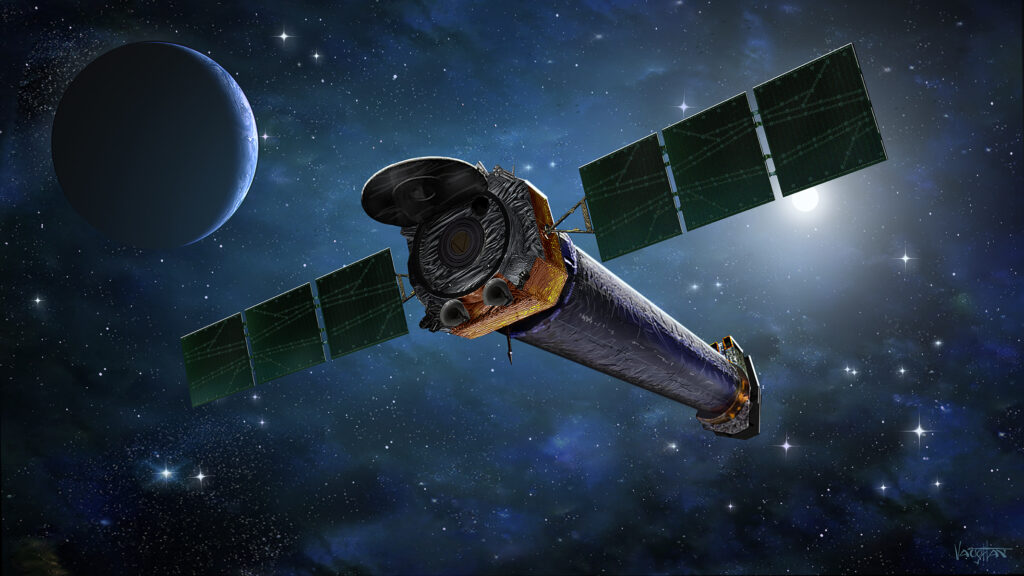
This past week, the American Astronomical Society’s annual Goddard Space Symposium was held. Typically, it has had many different panels, and this year was no different.
During one of the panels on the second day, Jared Rieckewald, Senior Director of SpaceLogistics, a subsidiary of Northrop Grumman, mentioned that they are working on an unsolicited proposal to service the Chandra X-Ray Observatory. This space telescope is one of only a handful of operational X-ray space telescopes, and it will mark 23 years in space this July.
The current servicing spacecraft that Northrop Grumman operates is called the Mission Extension Vehicle. Essentially, it is a standard satellite bus with extra fuel and a grabber on the front end to take hold of a customer satellite and move it into a different orbit or maintain its current orbit. The satellites that the MEV has worked with to date have been in geostationary orbit, 35,789 kilometers above the Earth. Chandra, however, is in an orbit a third of the way to the Moon or almost four times farther away than the geostationary satellites. It will need a much larger rocket such as SpaceX’s Falcon Heavy, if not something more powerful, to reach Chandra.
It is not clear that Chandra even needs a servicing mission at this point. And there’s the risk of propellant residue from the MEV inadvertently damaging the sensitive optics of the telescope, so the question is would these risks be worth it for a space telescope that is mostly functioning normally? Still, it would be an exciting mission, if for no other reason than to be able to assess how Chandra is holding up after more than two decades in high orbit.
On March 24, two more satellites were yeeted from the Japanese Small Satellite Orbital Deployer aboard the ISS. The first nanosatellite was KITSUNE, the first 6U, or 10 by 20 by 30 centimeters, CubeSat deployed using the J-SSOD. It has a camera capable of taking five-meter resolution images. KITSUNE also includes an amateur radio payload that will transmit a Morse code beacon that will describe the status of various systems on the satellite. It will also be used to demonstrate high rate data communications in the C-band, something not typically done on an amateur radio satellite.
The other satellite yote into space was called IHI-Sat. It is much smaller than KITSUNE, being only 3U, or 30 by 10 by 10 centimeters in size. Its purpose is to track ships at sea using the Automatic Identification System carried on most commercial ships. Knowing the position and speed of ships helps avoid collisions and can aid rescuers in the event of an emergency. The sensor on IHI-Sat improves on previous ones by being able to identify many more ships in crowded areas.
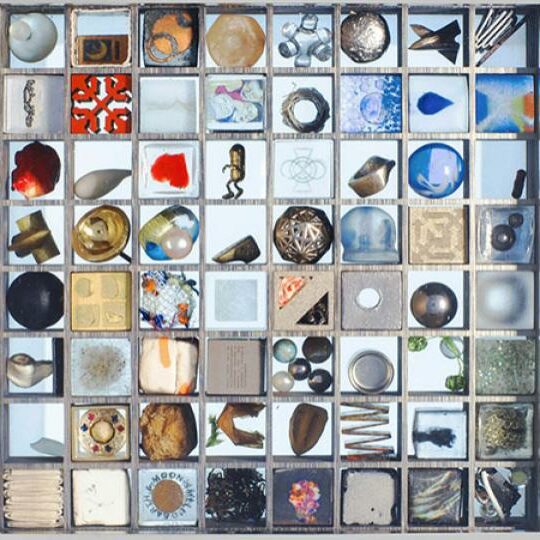
Not everything we report on here at Daily Space has to be about rockets and satellites. Sometimes, there are stories about space art to share with you, such as the “Moon Gallery” that traveled to the ISS aboard Cygnus NG-17 in mid-February of this year.
“Moon Gallery” is a purple rectangle with 64 one-centimeter square cells on one end. Each square has a small artwork, such as a tiny painting or a small sculpture, made by artists from around the world. Berlin-based Russian artist, Kristina Okan said: Moon Gallery is an incomparable challenge and a chance to rethink the art practice at a drastically new level. It is a chance to ask yourself a truly meaningful question and to test yourself to find a truly meaningful answer. Meaningful for yourself and for the universe, but only within 1 [cubic centimeter].
In addition to being a home for art in space, it has practical purposes. The effects of radiation and partial gravity on the various materials used for the works of art and the Nanoracks housing itself will be examined for the full duration of this journey.
The Moon Gallery has another practical purpose, too. It will also serve as a camera calibration target in the Nanoracks Nanolab on the ISS for ten months before being returned to Earth.
The gallery even has its own mission patch, which has a black background and the Moon Gallery wordmark in the center against a background of stars. One of the Os in the word “MOON” is a grid of 64 little squares representing the cells containing the pieces of art, while the other is a depiction of the International Space Station. Around the outside of the mission patch are references to the NG-17 mission, the year it went to space, and references to the “ISS Payload Gallery” and “Moon Gallery”.
The Moon Gallery Foundation plans future space galleries, with the ultimate goal being to place one on the Moon. According to their website, it is “becoming the seed of a new interplanetary culture”.
Next up, we’re going to talk about new research from Gaia on white dwarfs, and later, Erik will be reviewing a macro lens.
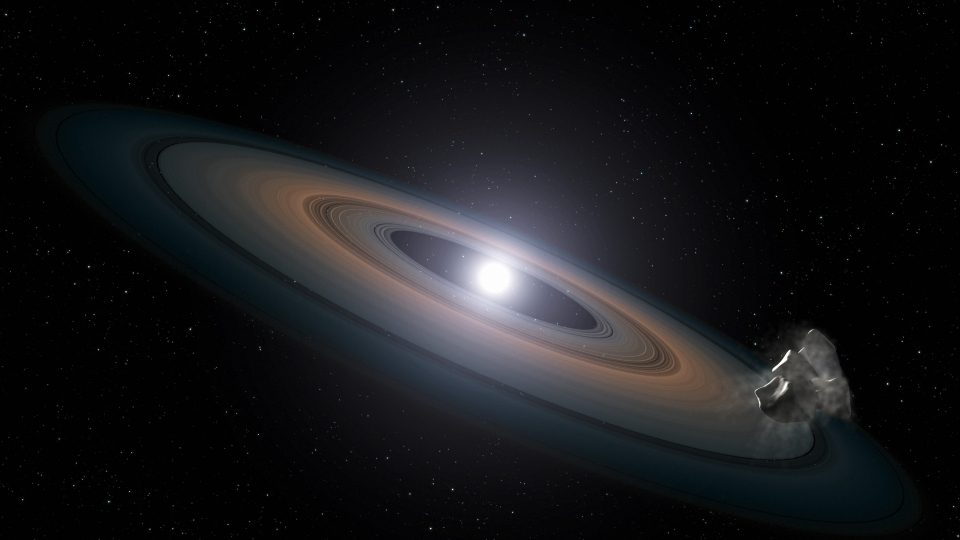
Yesterday, I wrote what was essentially a love letter to Gaia, and today I bring you yet more amazing science from my favorite telescope. In a new paper published in Monthly Notices of the Royal Astronomical Society and led by Daniel Mikkola, researchers use data from Gaia to discover that white dwarf stars have two different distributions both in how they move and how bright they shine.
White dwarfs are the leftover cores of stars like our Sun and smaller. They are no longer undergoing nuclear reactions, and their outer atmospheres have been exhaled to form planetary nebulae. These stellar remnants start out hot, hot, hot, but over time, cool off and fade away. If white dwarfs were simple objects, we could readily calculate how they cool in the same way a physics student might calculate the cooling of a rock heated up in a fire. This would also allow us to figure out things like how long the white dwarf has been there, hanging out, cooling. And that in turn, would give us an estimate of the age of the stars they are hanging out with.
But white dwarfs aren’t simple, and how they cool changes not just with how big they are, but also according to composition, and potentially also according to crystallization. In some models, the highly-dense material in these Moon-sized objects will change phases, suddenly turning into massive crystals as they cool. This state change causes the star to temporarily reheat before rapidly cooling. The details can be modeled, sort of, but are highly dependent on a lot of details we don’t always know about the stars we’re looking at.
Here is what we actually know: 120,675 white dwarf stars in the Gaia data set were analyzed by color, brightness, and motion. One of the populations is brighter and has stars with a wider distribution of velocities, and some of the white dwarfs are truly massive for still-minuscule white dwarfs. According to the paper: The bifurcation seen in Gaia clearly has contributions from both atmospheric differences as well as different WD mass cooling tracks. It remains unclear whether the origins of the massive WDs are recent bursts of star formation or a pile-up of WDs with a mixture of ages due to delayed cooling from crystallization, or a mixture of both.
And this is what makes science interesting. Sometimes you can get at the same result by following different paths, and we are always trying to understand is it one or the other or both? Here, it looks like the universe is playing a game of “yes, and” and allowing two different families of stars to emerge.

We’ve said it before and we’ll say it again: astronomy advances through the back and force development of both better computers and better telescopes.
For the past several decades we’ve all held up the same illustration, that on one piece of paper went from the Cosmic Microwave background light from the moment the universe became visible, and then in cartoon ways, on an 8.5×11 inch piece of paper, evolved from that light to the Swiss cheese structure of galaxy clusters and voids that we have in our modern universe. With surveys like the Sloan Digital Sky Survey and Dark Energy Survey, astronomers have been able to map out the distribution of galaxies at different periods of time and see how they match this diagram to a point.
While we can see the Cosmic Microwave Background, and we can see the distribution of galaxies changing over time, there is a period early in the universe that we know almost nothing about. Depicted in old diagrams as a lot of glowy gas and called the age of reionization, this is the period when the universe went from a lot of neutral gas to starting to form galaxies and stars; and this is a period of time that we haven’t been able to survey, yet.
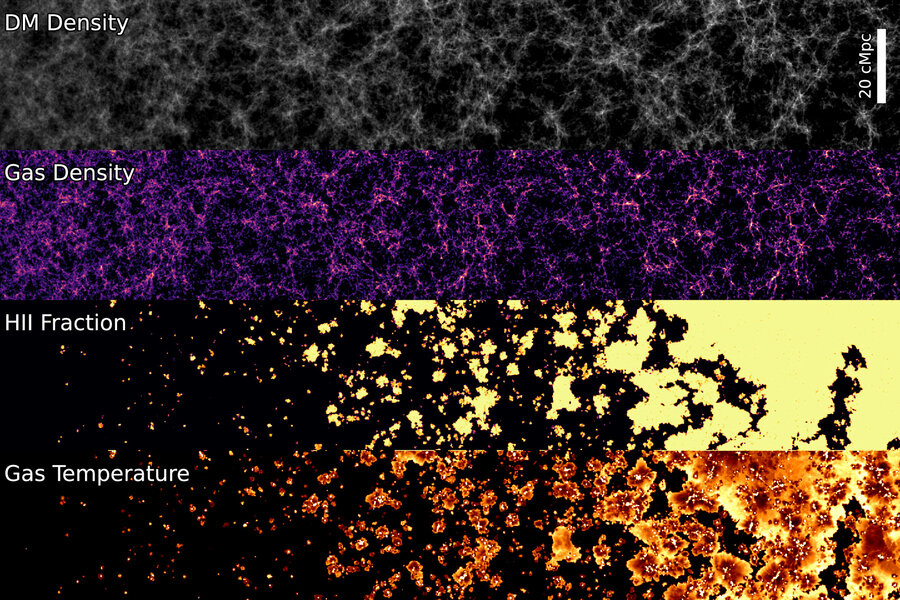
With the JWST so far seeming like it is going to work, we are starting to feel like maybe we will finally be able to survey that part of time and fill in more details. With these observations in (we hope) the near-ish future, modelers have been working to define the details of those early days.
And they are getting really cool results. The early universe saw more of an evolution of state than of structure. While the gas and dark matter density did change over time, the biggest changes seen in the models were in the amount of gas that was ionized, and thus transparent, and the overall temperature of the gas when it heated up as the first stars turned on.
If JWST lives up to its potential, we will be able to start seeing these pockets of visible and transparent gas around galaxies. Just as star-forming regions are wild structures with material that is forming stars and reveals pockets of these stars in the gas, young galaxies are pockets – really, really big pockets – of stars in the early universe.
And we will get to see this, not just in these computer models, but in the universe, if JWST works. There are a lot of hopes in that one spacecraft — a lot of hopes and dreams for science.
On a brighter note, next up, Erik brings us a review of a lens that does work and gives wide-angle views on the world and the sky.
Review

This lens is a little unusual. It’s a third-party lens made by Chinese company Venus Optics, which makes specialty lenses like ultrawide, macro, and even tilt-shift lenses for a variety of camera mounts. This lens is the Venus Laowa 15mm f/4 Macro.
Now, many manufacturers call lenses with magnification ratios from 0.25 to 0.5x or higher “macro” lenses. This isn’t one of them. According to the specs, it focuses all the way up to 1:1 magnification, so an object 36 millimeters long will fill the frame. The ultra-wide angle of view combined with the 1:1 magnification allows you to make quite interesting images.
One of the example uses for this lens, according to Venus, is for showing small insects in their natural habitat, but there’s a catch: the lens-to-subject distance at 1:1 magnification is just 4.6 millimeters. That’s about the size of your pinky’s fingernail, which means you will probably block almost all of your light with the lens in front of your subject at that distance. And you’ll probably scare the insects away, too.
Another catch is that the lens is fully manual without any electronics in it. This means you will need to manually focus, and your camera’s full auto-exposure mode will almost certainly not function. The manual focus and aperture rings, however, are nice and big, and with focus peaking on my Canon RP, I had no problems manually focusing accurately.
The lens body and mount are all metal, and the hood is plastic, which isn’t uncommon. Overall, the build quality was nice – it’s a very solid feeling chunk of glass.
In addition to a Canon EF version, Venus Optics makes this lens in Nikon F and Sony A and E mounts, and there is a Leica L mount version, too. I used an adapter with the EF mount to use it with my RP.
Speaking of the Canon EF version, you need to enable the “release shutter without lens” option to be able to use this lens because without any electronics in the lens the camera has no idea there’s a lens attached. On my RP, it’s custom function tab 7. If you use a body with in-body image stabilization like the R3, R5, or R6, you can use it with this lens after you manually input the lens’ focal length into your camera’s menu.
The quality of the images was good, with no flares or geometric distortion. There were no corrections applied in-camera, unlike my other lenses, because of the lack of communication between the lens and camera, but this didn’t cause any problems that I could see in the images when I went pixel peeping.
The major problem with this lens is the minimum focus distance. In my testing, I couldn’t get more than about 0.8x magnification without the front element of the lens hitting the thing I was trying to take a picture of, which is less than what was advertised. And when the lens was extended to its highest magnification, I found that the lens hood cast a lot of shadow on the subject. Removing the hood and adding a ring light helped a bit but not completely.
The lens design has a flat front element to allow the use of conventional filters, which helped me avoid damaging the lens when I rented it.
This lens also has a shift capability, where the lens body can be moved plus or minus six millimeters in the vertical direction, though I didn’t test this out myself. One major caveat is that the tilted image circle only covers APS-C-sized sensors. This capability is useful for taking pictures of buildings because it will keep the straight lines of the building from appearing to converge. To see this functionality in a $500 lens is unique – lenses with this capability often run into thousands of dollars.
I was excited at the prospects of taking ultrawide 1:1 macro images but was disappointed by the actual usability of the lens and not the build quality or quality of the images. Despite these limitations, I’m going to look at other specialized macro lenses from Venus Optics here on the Daily Space in the future, once I share reviews of the other lenses I own and use on a regular basis.
This has been the Daily Space.
You can find more information on all our stories, including images, at DailySpace.org. As always, we’re here thanks to the donations of people like you. If you like our content, please consider joining our Patreon at Patreon.com/CosmoQuestX.
Credits
Written by Pamela Gay, Beth Johnson, Erik Madaus, and Gordon Dewis
Hosted by Pamela Gay, Beth Johnson, and Erik Madaus
Audio and Video Editing by Ally Pelphrey
Content Editing by Beth Johnson
Intro and Outro music by Kevin MacLeod, https://incompetech.com/music/


 We record most shows live, on Twitch. Follow us today to get alerts when we go live.
We record most shows live, on Twitch. Follow us today to get alerts when we go live.